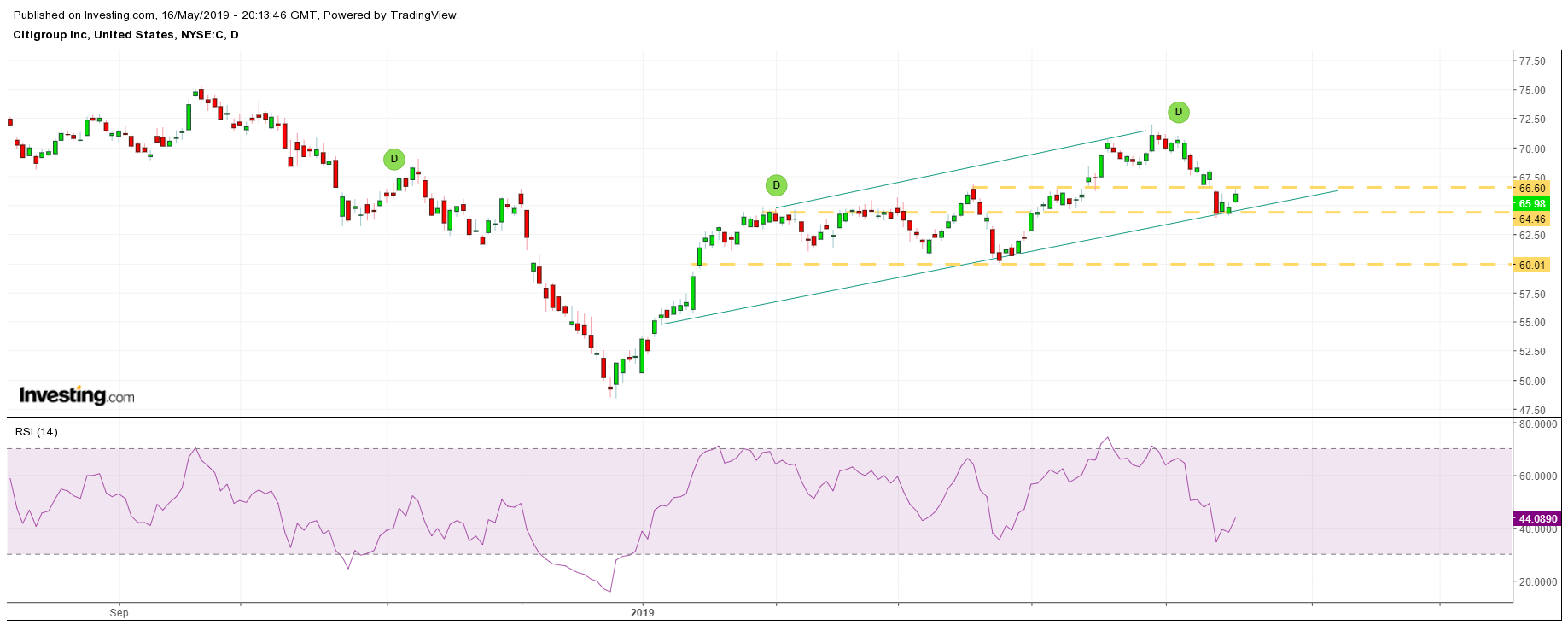This post was written exclusively for Investing.com.
Bank stocks were off to a hot start in 2019 but that may be about to change as trade tensions between the U.S. and China send shock waves through the equity markets and, more significantly for bank stocks, through the bond market.
The KBW NASDAQ Bank Index (BKX) had been up by over 21% through May 3, outperforming the broader S&P 500's 14% gain. However, since then it's plunged 4%, dropping 3.6% on May 13 alone.
So what's driving these moves? This has been an extended period of low interest rates and, intuitively, one would think that a low-interest rate environment would be bad for lenders' shares. And yet, the first four months of 2019 have proven that's not always the case.
The reason is that it's not the interest rate itself that's most important, but rather the spread between maturities on the yield curve that helps or hurts the banks.
Those spreads have been widening throughout most of 2019. However, with the equity market now in turmoil, there's been a flight into Treasury bonds, resulting in yields falling and the spreads narrowing. Contracting spreads have a negative impact on net interest income, which can reduce revenue and hurt profits. And that's where the key problem lies for bank stocks and big money center lenders, like JPMorgan (NYSE:JPM), Bank of America (NYSE:BAC), and Citigroup (NYSE:C).
Spreads Are Now Contracting
The chart below shows how the 10-year minus 2-year spread has risen since the middle of March, when it hit a low of about ten basis points. Since that time, the spread has been gradually rising, reaching an intraday high of 25 basis points on May 1. However, it has now started to contract, making a series of lower highs and lower lows indicating a change in trend, and that may be a bad sign for the banks.

JPMorgan
JPMorgan's technical chart reflects some of this pessimism. The chart shows the unfilled gap created in the middle of April following the bank's better than expected quarterly results. However, that positive mood has soured as the equity market has turned lower and as spreads on rates begin to narrow. Should the stock continue to decline, the next level of technical support comes at $106.50, roughly a 4% drop from the current stock price of around $111.30. However, should spreads continue to contract, the risk for a further decline is to around $102, a drop of over 8%.

Bank of America
Bank of America's stock is also weak, and like JPMorgan has a gap to fill at around $27.60. However, the chart suggests the stock could fall, to potentially as low as $26.60, a decline of over 7%, should support not hold. That would take the stock back to lows last seen in March, which was when spreads on the yield curve were at their tightest.

Citigroup
Citigroup's stock has the greatest risk for a severe decline with the potential for the shares to fall by as much as 9.5%. The shares are currently facing a strong level of technical resistance at $66.60, which may prove challenging to rise above. Additionally, they are sitting just above support at $64.50 and should they fall below that level of support, they may drop to as low as $59.80.

A Slowing Economy Bad For Banks Too
Additionally, should trade tensions rise any further between the U.S. and China, or worse, more tariffs be put into place, it could even put a dent into the U.S. economy. That would likely result in a slow-down in the housing market which could hurt the banks' ability to grow loans.
For now, the situation appears to be fluid, but if interest rates continue to fall and spreads continue to contract, they will create a major headwind for lenders. Ultimately, it doesn’t matter if rates are high or low; what may matter the most to the bank stocks is the spread on the yield curve. Currently, that spread is going the wrong way, and until that dynamic changes, it spells bad news for lenders.
